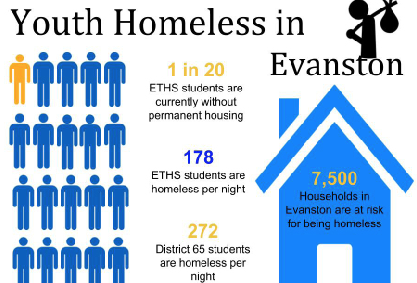Homeless students turn to Evanston polices for help

December 15, 2017
Although Evanston’s “Heading Home” policy is coming upon its’ fifth and final year, ETHS still has a higher percentage of students who experience homelessness than that of the state average.
“Unstable housing creates many challenges for students. Students’ performance might slip due to lack of sleep, new longer commutes to school, lack of food, and general stress related to precarious housing,” assistant professor of psychology at Lake Forest College, Sue Long says.
Beginning in 2012, “Heading Home” has been Evanston’s community-wide plan to manage and end homelessness within the city. The Mayor’s Task Force on Homelessness developed this five year plan to begin necessary programs and strategies, using both private and public channels.
However, Five percent of ETHS students experience homelessness compared to the two percent state average, as stated by the 2016-2017 Illinois Report Card. However, in order to ensure success, students have two resources available: the school itself and the greater community.
Students have access to school supplies, meals, clothing and a school-based health center at ETHS. The health center is partnered with NorthShore University HealthSystem. Additionally, any student is able to sign themselves up.
Yet, in order to receive the majority of services, one must apply, fitting the McKinney-Vento law standards. The McKinney-Vento law is designed to provide adequate access to education for those who qualify as homeless, defined as individuals who lack a fixed nighttime residence.
According to a 2013 study completed by Family and Youth Services Bureau, 51.2 percent of youth in U.S. experiencing homelessness were asked to leave their homes by a parent or guardian. 23.8 percent were physically abused or beaten, and 22.6 percent were having problems in the home due to a caretaker’s drug or alcohol abuse.
Although research has suggested family dynamic to be a primary cause of homelessness, some advocates for homeless youth in Evanston believe that affordable housing, or lack thereof, is a major factor.
“City Council’s plan to end homelessness, their plan for downtown development and their affordable housing plan are all out of date,” Connections’ Advocacy manager, Sue Loellbach says. “While the Council had a meeting on October 30 about affordable housing, they did not show any inclination to put a comprehensive, long-term plan in place.”
While the number of people who are homeless at any point is about 1,000 in Evanston, as reported by Connections for the Homeless, located in Evanston, the number of people who experience homelessness in a year is higher, close to 4,000. This includes 272 District 65 students, as well as, 178 ETHS students on any given night. Additionally, the number who are at risk of homelessness, classified by one spending more than 30 percent of their income on housing, is almost 50 percent of Evanstonians.
“We believe that these numbers are directly related to the lack of affordable housing and that the longer we go without significantly increasing the amount of affordable housing, the more people will be suffering,” Loellbach says.
The Inclusionary Housing Ordinance, the acting policy on affordable housing, states that privately funded developments must devote 10 percent of the total number of units to affordable housing. Moreover, for properties receiving public funds, 20 percent of the total units will go to affordable housing. However, businesses may also pay a sum of money into the affordable housing fund instead of the units.
Currently, the controversy has grown after the Albion 15-story development was approved,with nine percent given to affordable housing units. The Albion is one of many luxury housing units brought to Evanston, creating a dispute of gentrification and the influence on the population.
“It’s naive to talk about affordable housing without talking about gentrification,”Spanish teacher, Clare Delgado says. “We are displacing 50 to 100 units of affordable housing by jacking up the rate through the contribution of gentrification.”
According to the Chicago Tribune, between 2004 and 2013, prior to the current “Affordable Housing Ordinance”, Evanston lost 40 percent of its affordable housing. Additionally, the black population has declined by 7 percent.
“Even working people can’t afford to live here anymore,” Delgado says. “Evanston has become so unaffordable. When it’s unaffordable, people can’t afford to buy a home.”
Youth experiencing homelessness at ETHS, and in the greater Evanston community, face various challenges day to day. While there are policies and protection put into place at ETHS to aid students through this time frame, the policies of Evanston also impact homelessness on the student-level.


















